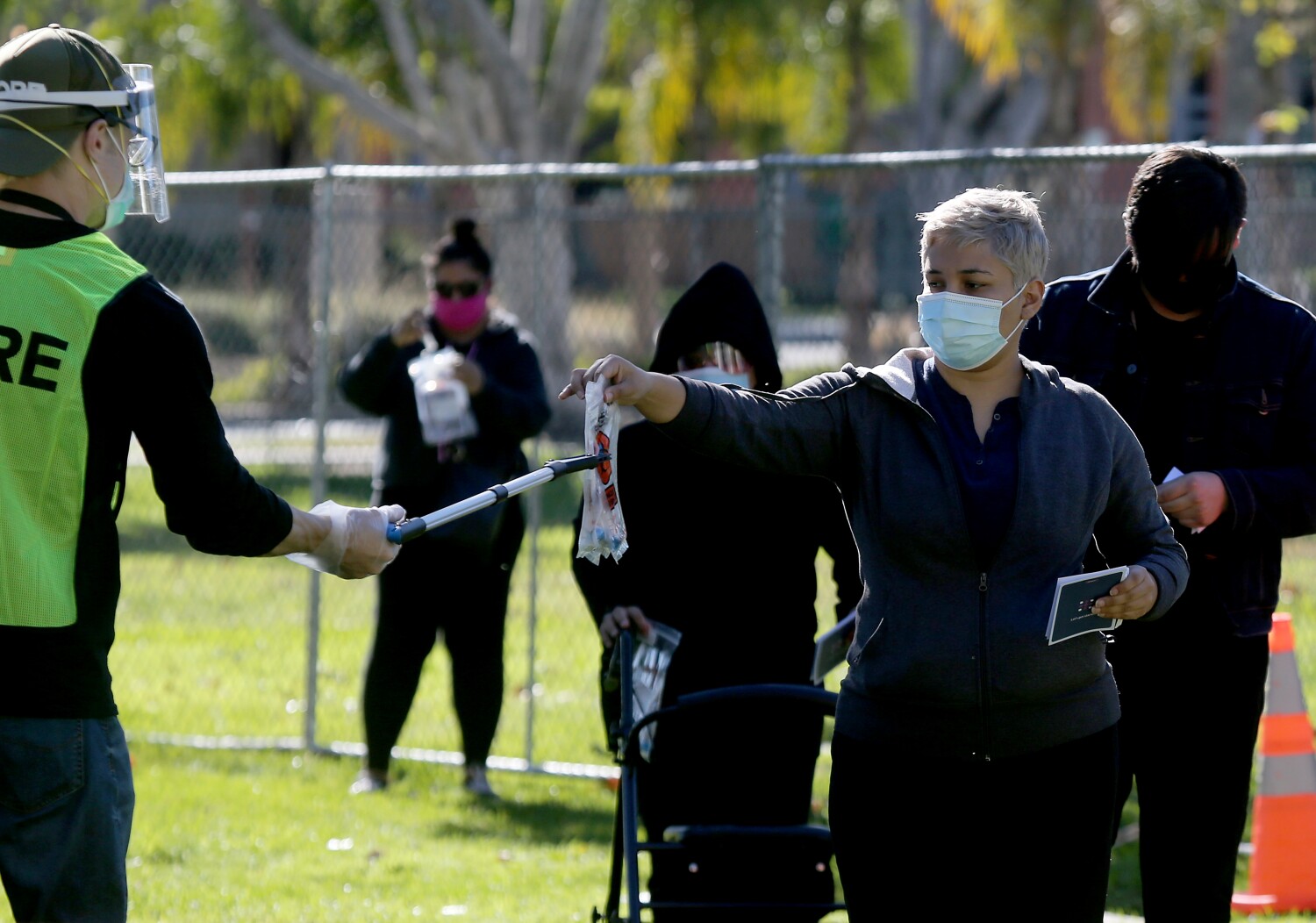[ad_1]

It took almost 10 months for California to record its millionth confirmed coronavirus case.
Now, just six weeks after crossing that morbid milestone, the state is on the cusp of surpassing 2 million.
The staggering rate of growth demonstrates how widely the coronavirus is now circulating statewide and underscores the reality that activities and behaviors thought to be relatively safe just weeks ago now carry a higher risk of infection than ever before.
“Without sustained efforts to stop the surge, we can expect that this tragic trajectory will continue,” Los Angeles County Public Health Director Barbara Ferrer said Monday.
There are now 1.93 million confirmed coronavirus cases in California, according to data compiled by the Los Angeles Times.
That total includes 62,661 new cases reported Monday alone — by far the most confirmed in a single day since the pandemic began.
California is now averaging nearly 45,000 new coronavirus cases a day over the past week — more than seven times the comparable figure from six weeks ago.
At that rate, cases in the state will cross the 2-million mark as soon as Wednesday.
With coronavirus transmission this widespread, experts say it’s more important than ever to take steps to prevent infection — by wearing masks in public, regularly washing your hands and staying home as much as possible.
The ramifications of the exponential climb in confirmed cases reach far beyond a public health spreadsheet or newspaper headline. Every newly announced batch foreshadows the inevitability of more people falling seriously ill, with some eventually dying from COVID-19.
“We are anticipating a substantial increase in the hospital surge,” Gov. Gavin Newsom said Monday.
Already, the number of COVID-19 fatalities, like cases and hospitalizations, has reached unprecedented levels. California has averaged 247 daily deaths over the last week, more than double the numbers seen two weeks ago.
Almost 23,000 Californians have died from COVID-19 since the pandemic began.
On Sunday, the most recent day for which complete data are available, there were record-high numbers statewide of coronavirus-positive patients hospitalized — 17,190 — and in intensive care — 3,644.
Those numbers have ballooned by 71% and 54%, respectively, over the last two weeks.
Officials say they expect those statistics to climb further as some of the recently infected fall ill and start showing up in emergency rooms.
Dr. Mark Ghaly, California’s Health and Human Services secretary, said Monday: “We believe that 12% of today’s cases will be hospitalized 12 days from now, and then 12% of those hospitalized patients will be admitted to the ICU for critical care needs.
“Looking at the cases day-over-day and the trajectory we are on,” he said, “we are worried that certain regions do exceed their existing capacity — and even may go beyond the existing surge capacity that they currently have planned.”
Of particular concern are the state’s ICUs, which provide specialized care to those who are critically ill or injured.
The torrent of COVID-19 patients has stretched some of those units to their limits. As of Monday, ICU availability remained at 0% in both Southern California and the San Joaquin Valley, according to state figures.
That doesn’t mean there are no unoccupied beds, as the state uses a weighted formula to ensure that some remain open for non-COVID patients. But officials and experts warn that an overcrowded ICU can overburden doctors and nurses, imperiling the quality of care for everyone who needs it.
“It is true that some counties, or some regions, may begin to exceed their existing stated hospital capacity — not just ICU capacity — by the end of the month and early in January,” Ghaly said. “We don’t see that across the entire state quite at that time, but we’re watching it very closely.”
Statewide, 2.5% of ICU beds were available as of Monday.
In L.A. County, home to 10 million people, a point-in-time survey found that there were 30 available ICU beds as of 9 a.m. Sunday, significantly down from a tally last week that found 69.
Over the weekend, one hospital struggled to care for a high number of COVID-19 patients while treating members of a large family critically injured when struck by a suspected drunk driver, according to county Health Services Director Dr. Christina Ghaly.
Given that the county’s hospitals are already feeling the strain, recent images of “people out and about, lots of people in parks … busy shopping centers and retail centers” are tremendously troubling, she said Monday.
Along with urging everyone to stay home as much as possible, state and local officials are asking residents to forgo plans to travel for the winter holiday season or celebrate with anyone they don’t live with.
The failure of many to follow those restrictions for Thanksgiving has fueled the recent record infection numbers, officials say. Making the same choices this time around could both prolong and intensify the surge — exacerbating the strain on healthcare systems.
“If you’re still out there shopping for your loved ones for this holiday season, or you’re planning a holiday get-together, then you are missing the gravity of the situation that is affecting hospitals across Los Angeles County and California and this nation,” Christina Ghaly said. “People are very sick in the hospital. They are dying there. And our hospitals may not have the equipment or the capacity or the resources to take care of you in the way that you need or expect.”
Times staff writers Jennifer Lu and Casey Miller contributed to this report.
[ad_2]
Source link